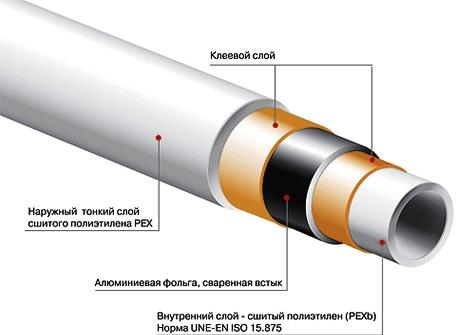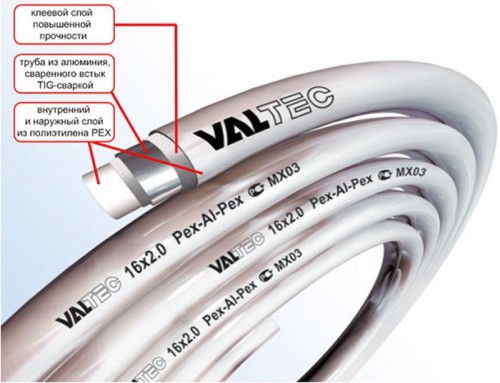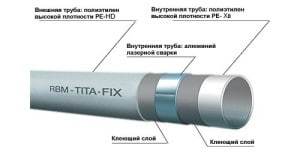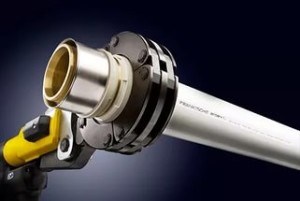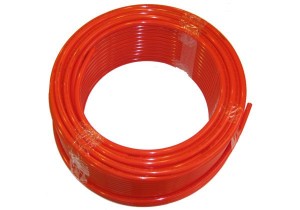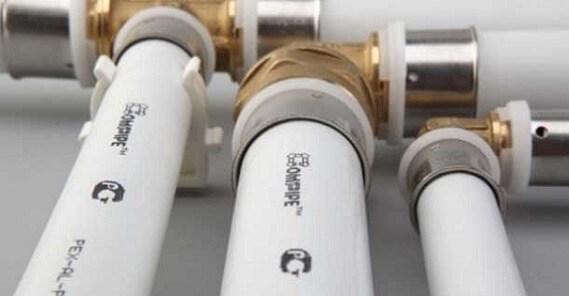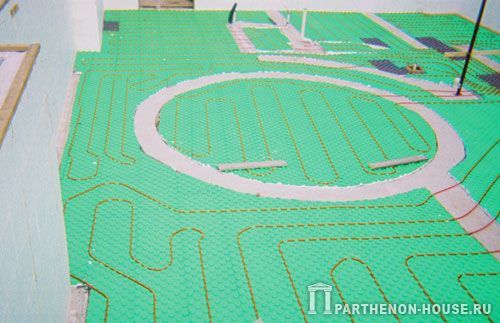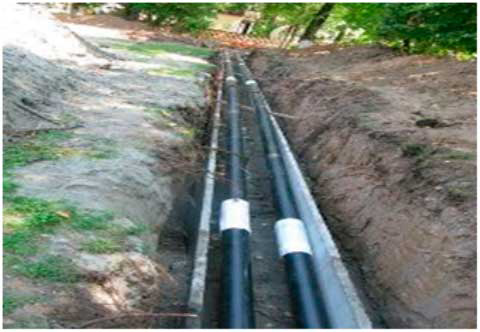Advantages of ordering products in our store
- Wide range of pipes. You can order products of the desired length and optimal diameter from us. Production is delivered in bays. This simplifies the process of transportation and use.
- Sophisticated feedback system. All questions about the quality of the proposed pipes, their characteristics, you can ask our specialists. Managers will talk about the features of the products. Experts will help you quickly make a choice in favor of those pipes that are able to successfully solve all the tasks.
- The possibility of exchanging goods of inadequate quality.
- Fast dispatch approval and order confirmation. Sale of all production is carried out by us on conditions, convenient for clients.
- Prompt delivery in Moscow and other cities.
Contact us! Specialists will answer all questions regarding the sale of pipes and their return.
The advantages of metal-polymer (metal-plastic) pipes are the absence of corrosion, resistance to overgrowing, aggressive building mixtures, strength, smooth inner surface, convenient transportation, technological, economical installation, impermeability to gas molecules, relatively small thermal linear elongation. Metal-plastic pipes VALTEC are widely used in the installation of water supply systems, heating, cooling of buildings, transportation of various technological media, including food.
The crosslinking of the polyethylene of the inner, outer layers of the proposed metal-polymer pipes is carried out using the organosilane method (PEX-b). The inner (working) layer has a degree of crosslinking of 65%, the outer (protective) layer of PEX has a degree of crosslinking of 55%. Such a constructive solution makes the pipe more flexible. The metal layer is butt-welded from pure aluminum foil with a thickness of 0.25–0.4 mm (for different sizes). The aluminum of the middle layer is welded by the TIG method, while the strength of the weld exceeds the strength of the aluminum layer itself. The strength of the adhesive bond of the layers is 70 N/10 mm, while the standard is 50 N/10 mm. Multiple temperature drops will not cause delamination of the metal polymer.
Metal-plastic pipes VALTEC PEX-AL-PEX can be used in radiator heating (5th class of operation, GOST 32415-2013). Compliance with passport operating conditions guarantees a 50-year service life of the product. The warranty period for VALTEC PEX-AL-PEX pipes is 10 years.
Metal-polymer pipes are a great combination of metal and plastic products.
They have proven themselves as a material for cold and hot water supply, heating, underfloor heating systems, and transportation of process fluids. Subject to all recommendations for installation and use, their service life can be up to 50 years.
Pipeline Valtec
Valtec metal-polymer pipes have been especially popular lately. They are used for heating, water supply, and cooling of buildings. The secret of the success of Valtec products lies in the strict control of the production process and the high quality of the raw materials used.
Valtec uses an organosilane cross-linking method (PEX-b). The manufacturer crosslinks the inner layer by 65% and the outer layer by 55%. This allows Valtec to produce products with high strength and excellent flexibility at the same time.
Also among the distinguishing characteristics of Valtec products include:
- Light weight and practical length, which allow you to transport and install the pipeline without any special difficulties;
- Excellent sound absorbing properties. Even with open installation, pipe lines do not need additional sound insulation;
- The possibility of hidden laying under a concrete screed, due to a small coefficient of linear expansion;
- High resistance to aggressive environments, which allows the pipeline to be used for transporting process fluids;
- Easily acquire the necessary shape and hold it;
- They have a diameter range from 16 to 40 mm;
- The thickness of the pipe wall in the section is from 2.0 to 3.5 mm;
- The manufacturer's warranty is 10 years.
In addition to the pipes themselves, the manufacturer also produces Valtec compression and press fittings. They are produced in all standard sizes and are ideally suited for the pipeline of the same name. Valtek fittings are distinguished by excellent quality and maximum ease of use.
Metal-polymer pipes, as the name implies, are composed of metal and polymers. The structure and materials used in this case are different, but products with a layer of aluminum foil protected on both sides with polymeric materials and polymer pipes with an internal mesh metal frame are widely used. Manufacturers of metal-polymer multilayer pipes present both versions on the Russian market.
Features of metal-polymer pipes
Manufacturing technology
The technology for the manufacture of pipe products from metal polymers involves several stages:
- The inner shell is extruded from a special device (extruder).
- On top of the shell, using a special adhesive layer, a carrier layer of aluminum foil is applied, which is welded along the seam by laser butt or overlap.
- An extruded outer shell is glued onto the aluminum layer.
- All layers are pressed simultaneously.
The outer layer of the pipe protects aluminum from oxygen and moisture. The aluminum foil ensures the strength of the product, and the inner layer is designed to protect the product from the effects of the working environment and the formation of condensate.
Advantages over metal products
Thanks to this technology, metal-polymer multilayer pipes obtain physical and mechanical characteristics, due to which they are significantly superior to metal pipes. First of all it is:
- resistance to corrosion and aggressive environment;
- good heat resistance;
- ease of installation;
- preservation of the geometric shape after bending;
- resistance against internal deposits;
- high throughput, etc.
Purpose and marking of products
Metal-polymer pipes are used for laying water pipes, heating and sewerage systems. They are also quite suitable for gas.
For a clear, unambiguous classification of products, international marking of metal-plastic pipes has been adopted. The main purpose of applying information is to convey to the buyer a maximum of useful data about the product.
The following instruction will help you understand the marking, revealing the main encoding:
- Type of plastic used for the manufacture:
- PEX-AL-PEX - cross-linked polyethylene;
- PERT-AL-PERT - heat-resistant polyethylene;
- PE-AL-PE - plain polyethylene;
- PP-AL-PP - polypropylene.
- Products made of cross-linked polyethylene in the abbreviation may contain letters that indicate how the material is cross-linked (a-pyroxide, b-silane, c-electronic).
- Product diameter and thickness (minimum) of the wall. The value is entered in millimeters or inches.
- The nominal (working) pressure for which the pipe is designed. If the operating pressure is observed, metal-polymer pipes can withstand more than 50 years of operation without deformation and other violations of technical characteristics.
- Maximum pressure. Actual parameter for piping products designed to transport a working medium with a high temperature.
- Information about the working medium that can be transported through pipes.
- Batch number and production date.
Product labeling example
Connection methods
The use of metal-plastic pipes for laying pipelines requires solving problems with connecting products to each other or fitting products.
To ensure reliable connecting nodes, the following are used:
- Threaded fittings with sealing split ring.
- Press fittings.
Threaded fittings are easier to install and require no special tools. However, this type of connecting unit is the main disadvantage of metal-polymer products, since the connections lose their tightness over time and require constant monitoring and tightening.
The connecting nodes formed with the help of press fittings are more reliable, however, they are one-piece and a special press tool is required for their organization.
Multilayer metal-polymer pipes with an aluminum layer
Most of these pipe systems are designed to organize heating systems (including floor heating) and water supply (cold and hot). The design of products is indicated in GOST R 53630-2009 for metal-polymer multilayer pipes.
Layer structure:
- outer;
- adhesive;
- barrier;
- adhesive;
- interior.
Materials for the manufacture of metal-polymer pipes
In the production of metal-polymer pipes (MPT), the following can be used:
- ordinary polyethylene, PE or PEHD - for low-pressure cold water supply systems;
- heat-resistant polyethylene, PERT - for cold and hot water pipelines, as well as heating (up to 70 ° C) of medium pressure;
- cross-linked polyethylene, PEX - high pressure and temperature pipelines, UV resistance (from individual manufacturers);
- polypropylene.
The thickness of the aluminum layer is different for different manufacturers of metal-polymer pipes and can be different in assortment even within the same production. The thickness of the aluminum layer affects the rigidity of the pipe and must be selected based on the task.
The adhesive composition is extremely important, because it is he who forms a single, albeit multilayer, structure of the MPT. The main requirement is good adhesion to aluminum and polymer. The best manufacturers of such adhesives:
- Equistar, USA;
- Hyundai, South Korea;
- Mitsui, Japan.
Russian manufacturers of MPT
The best Russian MPT manufacturers produce products not only for heating and water supply, but also for many technical and technological pipelines.
Products under the COMPIPE trademark are produced in the Moscow region (Kashira), and since 2015, partially in Switzerland. In addition to the standard purpose, pipes are used in the distribution of intra-house gas pipelines, in heating open areas, and in the organization of "warm floors". The quality of MPT COMPIPETM made of cross-linked polyethylene, according to reviews, is high. There is feedback from the manufacturer. The company also manufactures fittings, fittings and tools under the Comtek brand.
NPP "Mayak-93" are not only manufacturers of MPTs, but also develop and supply equipment for their production. In addition to the above capabilities, their pipes are designed for laying and insulating electrical wiring, in the systems of ships and trains of Russian Railways, as well as for technological needs (compressed air, aggressive liquids).
For heating and water supply, the Kazan metal-polymer pipes enterprise produces MPT, in which the inner and outer layers consist of polypropylene. The aluminum foil is overlap welded. The thermal conductivity of the walls is lower than with polyethylene protective layers, therefore, the coolant loses less thermal energy in the route.
The company "Komplekt-service +", Tatarstan, manufactures products according to European technology and from European materials, however, their metal-polymer pipes comply with GOST R 53630-2009 and TU approved by the Research Institute of Sanitary Engineering. They also use high temperature polypropylene as a protective layer with high chemical resistance. Operating temperature - up to +110 °С.Produced fittings for metal-polymer pipes are universal and suitable for both MPT and polypropylene pipes.
The joint production of Russia and Italy produces Valtec pipes with polyethylene in protective layers. Production features make it possible to use such MPTs with frequent changes in ambient temperature with short-term "peaks" up to 130°C.
Foreign suppliers of MPT
The leaders in sales are recognized manufacturers of multilayer metal-polymer pipes with technical characteristics that meet all the requirements of long-term operation. Issued guarantees are often 10 years, which indicates the confidence of the manufacturer in their products. Here are just a few of them:
Variety FRÄNKISCHE ROHRWERKE
- FRÄNKISCHE ROHRWERKE, Germany;
- HERZ, Austria
- HENCO, Belgium
- RBM, Italy;
- TECE, Germany;
- REHAU, France;
- GIACOMINI, Italy;
- COES, Italy.
There are many Italian and German manufacturers of high-quality MPTs. There are also manufacturers from Korea and China on the market. When choosing the technical characteristics of metal-polymer pipes from various manufacturers, take the time to study the product labeling. There are many fakes on the market, especially HERZ and HENCO, which do not match the original pipes in any way.
GIACOMINI smooth and corrugated pipes for gas supply
Metal-polymer pipes have proven themselves in heating, water and gas supply, and other areas. Products have a long service life and reliable warranties, but beware of fakes and poor-quality installation - contact the professionals.
GOST requirements for the manufacture of metal-plastic pipes
Requirements for the quality of manufacture of metal-plastic pipelines are presented by GOST 53630-2009. The normative document defines the main classes of material in terms of diameter, as well as the maximum working pressure, regulates the raw materials for production, the procedure for packaging and transporting products.
According to GOST, metal-polymer pipes are divided into two main groups depending on the diameter:
- Products 10-63 mm;
- Products 75-110mm.
GOST also regulates the production of products with the following nominal pressure:
- 0.6 MPa;
- 2.5 MPa.
The pipeline, manufactured in accordance with GOST, has a confirming quality certificate
You should pay attention to this when purchasing materials in stores.
GOST also determines the labeling of products. The first thing that manufacturers should indicate is what plastic is used to make the pipe. There may be several options:
- PE - polyethylene;
- PEX - cross-linked polyethylene;
- PERT - heat-resistant polyethylene;
- PP - polypropylene.
If cross-linked polyethylene is used for production, a letter designation (a, b, c) is applied to the product, indicating the method of cross-linking.
The device of a heat-insulated floor from metal-polymer pipes
Due to the long service life, high manufacturability and ease of installation, metal-polymer pipes can be used for underfloor heating in a country house. The use of underfloor heating as a heating system for a country house is more efficient than conventional batteries, primarily in terms of efficiency (in the Scandinavian countries, which are closest to us in terms of climatic conditions, over 80% of houses are currently equipped with underfloor heating). Savings occur due to the fact that with a warm floor there is no longer a need to increase the power of heating systems in order to warm up the coldest zone to which the floor belongs.
Before the advent of metal-polymer pipes warm floor
arranged only with the help of electrical cable systems, where the heat source was an electric heating element (cable) laid in a concrete floor. By using metal-polymer pipes instead of a cable, you can refuse to use expensive electricity and, moreover, there is no need for additional insulation and grounding work.
In principle, work on the installation of a warm floor from metal-polymer pipes is carried out in the following sequence;
1. The base of the floor is covered with a layer of heat-insulating material, on which aluminum foil is laid to reflect heat rays.
2. Then a contour of several turns of a metal-polymer pipe is laid out on the floor, indicating the necessary heating zones.
3. All together pour concrete with a layer thickness of 3-5 cm.
4. When the concrete hardens and gains its strength, it can be covered with any finishing material; parquet, linoleum, carpets, ceramic tiles.
The main advantage of a warm floor from a metal-polymer pipe is that heat radiation does not begin 20-40 cm from the floor, as when using wall-mounted radiators or heating panels, but the floor itself is heated. Due to this, the most comfortable temperature balance is created in the room with a smooth decrease in height.
From the point of view of maintaining the health of the inhabitants of the house, this scheme is more preferable than with the usual batteries under the window, in which the cold floor is combined with warm air rising from the batteries, which creates a large temperature difference and provokes drafts.
The most justified arrangement of underfloor heating from a metal-polymer pipe in the bathroom, as well as in saunas and pools.
3 Terms and definitions
In this standard, the following terms are used with their respective definitions:
3.1 multilayer pressure pipe: A pipe containing more than one load-bearing layer.
Note - Pipes with outer layers not designed for load are subject to the requirements of GOST 32415 for hydrostatic strength and design stresses, which are provided by the main inner polymer pipe.
3.2 multi-layer M-pipe: A multi-layer pipe containing one or more polymer layers, which is designed for a load, and a metal layer, which is designed for a load (for example, PE-Xb/AL/PE-Xb pipe).
Notes
1 At least 60% of the pipe wall thickness is made of polymer.
2 For pipes with polyethylene/aluminum/polyethylene layers with an aluminum longitudinally welded layer (designed for load) hidden in the middle of the pipe wall thickness, the previously accepted term "metal polymer pipe" is allowed.
3.3 multilayer P-pipe
3.4 inner layer layer in contact with the transported liquid
3.5 outer layer layer exposed to the environment
3.6 hidden layer: The layer that lies between the inner and outer layers.
3.7 standard metal layer dimension ratio
3.8 standard polymer layer size ratio
3.9 nominal outer diameter mm
3.10 mean outside diameter, mm
3.11 nominal wall thickness, mm
3.13 lower confidence limit for predicted hydrostatic pressure p value in terms of pressure representing the 97.5% lower confidence limit of predicted hydrostatic pressure at temperature and time p
3.14 long-term hydrostatic pressure
3.15 working pressure, MPa: The maximum water pressure in the pipeline under given operating conditions.
3.16 safety factor : Dimensionless value, having a value greater than one, taking into account the operating conditions of the pipeline, as well as its properties not taken into account in the lower confidence limit .
CLAIM
Method for connecting multilayer metal-polymer pipes by welding through a connecting device having at least two connecting elements with seating sockets for end sections of pipes, along the outer, internal and end surfaces of the end section of the pipe, covered by the internal surfaces of the seating socket of the connecting device, with preliminary simultaneous heating of the end section of the pipe and the seat of the connecting device and subsequent combination of pre-heated sections of the pipe and the connecting device, characterized in that in order to prevent the destruction of the polymer layers, the exposure of the inner metal layer and the removal of the adhesive layers of the pipe deposited on the metal layer when combining it with the connecting device, the end section of the pipe is heated to the softening temperature of the material of the outer and inner layers of the pipe, and the seat of the connecting device, made in the form of a coaxial with an inner opening of the seat of the connecting element of the connecting device of the annular groove with a cylindrical wall on the side of the outer surface of the connected pipe, and a conical wall truncated along the plane of the end of the connecting element, on the side of the inner surface of the connected pipe, is preheated to the melting point of the material of the connecting device, while pre-heating of the end section of the pipe and the seat of the connecting device is carried out using a welding fixture having a control unit and a heater on which the pipe tool and the fitting tool are located, while the temperature of the heater and the fitting tool having direct contact with the surface of the heater is equal to the melting point of the material connecting device, is set by the control unit and maintained by it at a constant level within a given error, while Limiting the heating of the final section of the pipe to a temperature not exceeding the softening temperature of the material of the outer and inner layers of the pipe is ensured by fixing the pipe tool on the heater through the adapter sleeve, while to adjust the heating temperature when external conditions change, the pipe tool can move along the axis of the adapter sleeve.
Multilayer metal-polymer pipes technical characteristics
The experience of European countries has shown that metal-polymer pipes are not inferior to metal products in terms of reliability and service life. Based on the cost and degree of installation complexity, metal polymers even win compared to other materials.
In Russia, this material is not widely used. Experts believe that this situation is due not to the quality of metal-polymer products, but to the low qualifications of domestic builders and the need for hydraulic testing of pipelines from this material.
For low-rise construction, metal-polymer pipes are an almost ideal material, as they have the following positive properties:
- the ability to retain shape after bending, which allows the use in hard-to-reach places;
- ability to withstand a load of +95 degrees and 10 bar;
- suitability for use in water pipes intended for drinking water;
- 100% impermeability of any gases;
- resistance to the formation of biological and salt deposits;
- low roughness of the inner surface, which makes it possible to reduce hydraulic losses and use products with a relatively small diameter;
- electrical conductivity;
- low thermal conductivity, which does not allow condensation to form;
- ability to extinguish hydraulic and acoustic waves;
- the pipeline for water supply does not require insulation;
- the possibility of connecting with pipes made of other materials;
- durability - with proper installation, they can serve 30 - 50 years without aging and without reducing throughput;
- fast installation due to the use of fittings;
- the ability to monolith the pipeline using press connections.
The positive properties of metal-polymer products are provided by the properties of the polymer. Its relatively low cost allows organizing mass production with automation of all processes. Physical and chemical properties make it possible to use metal polymer products in pipelines for various purposes.
In addition to the advantages, metal-polymer multilayer pipes also have some disadvantages:
- a large coefficient of linear expansion and instability to temperature changes significantly reduce the service life;
- in the pipeline for hot water, it is necessary to use U-shaped compensating elements on bends;
- fastening elements should not interfere with the linear movement of the pipe;
- if sudden temperature changes are allowed in the heating system, stratification begins;
- short-term freezing reduces the service life;
- a special tool is required for the installation of press-connections;
- The imaginary simplicity of crimp connections leads to the installation of low-quality pipelines during their independent construction.
Selection criteria - what to look for
When purchasing fittings and metal-polymer pipes, the manufacturer is of great importance. Only products of well-known and trusted manufacturers have a certificate of the State Standard of Russia, a Hygienic Certificate and a Fire Safety Certificate (including a test certificate for the release of substances harmful to humans in the event of a fire). You should not buy products if the seller cannot provide all the documents, as there is a possibility of purchasing an outdated or fake product.
Pipes intended for the heating system must have an additional certificate. The technical documentation must also indicate resistance to the penetration of gases. After all, the presence of oxygen in the heating system contributes to the occurrence of corrosion processes in radiators and boilers.
Repair of metal-plastic pipes

